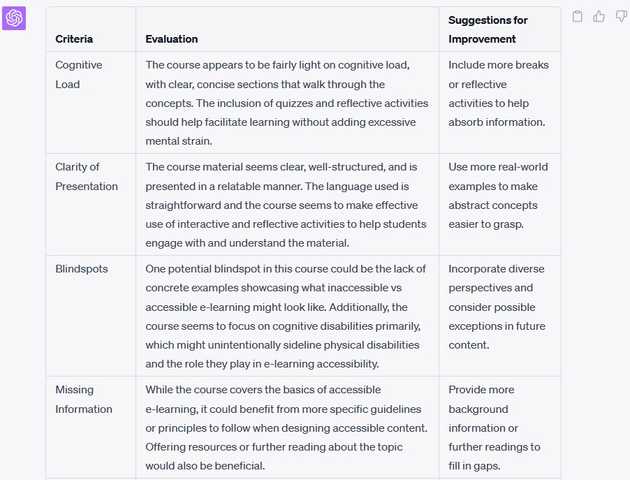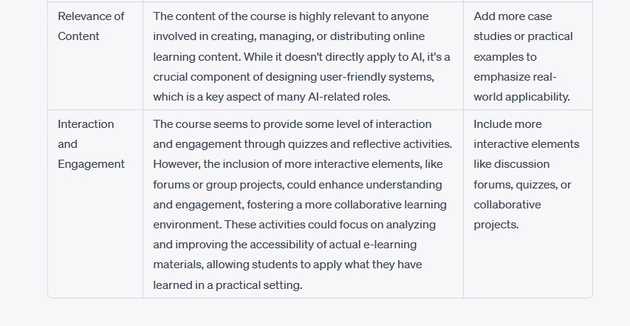
In our mission to create effective and engaging learning experiences, the importance of feedback can never be overstated. It is a crucial element in the instructional design process. It provides us with insights that can lead to continuous improvement and innovation in e-learning design and delivery. In this post, we are going to discuss a ChatGPT prompt designed to help instructional designers offer comprehensive feedback on e-learning courses.
The below prompt encourages a critical evaluation of the e-learning course across various criteria, providing a well-rounded perspective of the course’s effectiveness. This approach can help instructional designers identify gaps in content, detect potential biases, analyze relevance and practicality of content, and evaluate the effectiveness of multimedia elements and learner engagement strategies.
ChatGPT Prompt:
You are simulating a learner who has just completed the above course. As part of the pilot team, you’re tasked to provide comprehensive feedback based on these criteria:
- Cognitive Load: Reflect on the perceived mental effort that would be required to understand the course material, taking into account the complexity of the concepts, the workload of assignments, and the pacing of the course.
- Clarity of Presentation: Consider how understandable the course material might have been for an average student, including the clarity of instructions, explanations, and usage of real-world examples.
- Blindspots: Reflect on possible topics or perspectives that might have been overlooked in this course. Are there any biases you might have detected in the way the content was delivered?
- Missing Information: Think about potential missing information or context which would have been beneficial to understanding the subject better.
- Relevance of Content: Evaluate how the content of the course connects to real-world applications.
- Interaction and Engagement: Reflect on the opportunities provided for active learning and engagement during the course.
Include a column ‘Suggestions for Improvement’
Please present your analysis in a table format, simulating a student’s perspective, using your vast corpus of knowledge about human learning experiences and pedagogy.
Each of these criteria offers a unique lens through which we can evaluate our e-learning course:
- Cognitive Load reflects the mental effort required by learners to understand the course material.
- Clarity of Presentation focuses on the understandability of the course material.
- Blindspots helps us identify overlooked topics or perspectives.
- Missing Information prompts us to consider any gaps that could have been beneficial to understanding the subject better.
- Relevance of Content evaluates how well the content connects to real-world applications and job prospects.
- Interaction and Engagement reflects on the opportunities provided for student interaction and engagement during the course.
We tried this approach with a chapter from our “Introduction to Accessible Learning” course. The feedback generated was insightful and led to several improvements in the content, design, and delivery of the course.
The output we receive:
So, next time you complete a course, why not give this feedback prompt a try? It might just lead to the most impactful improvements in your e-learning courses. Happy designing!


